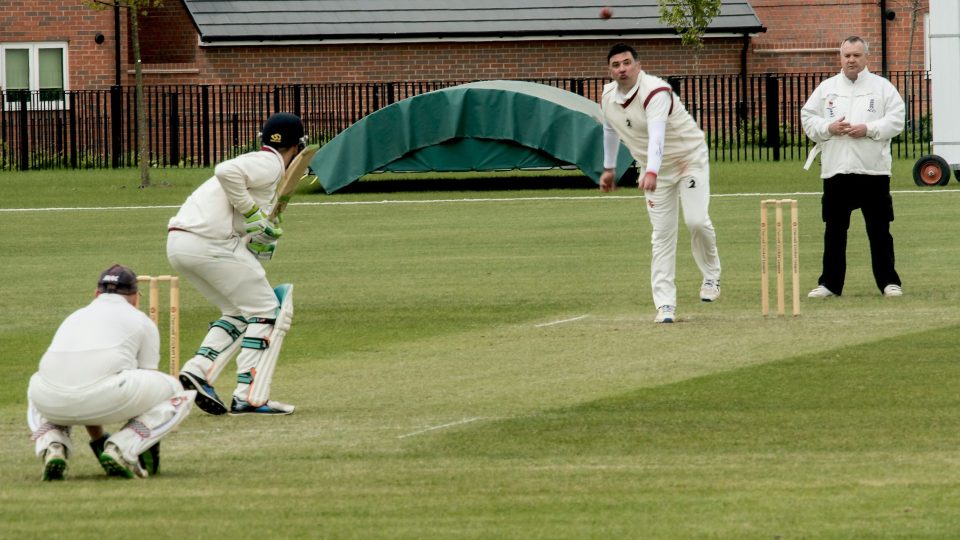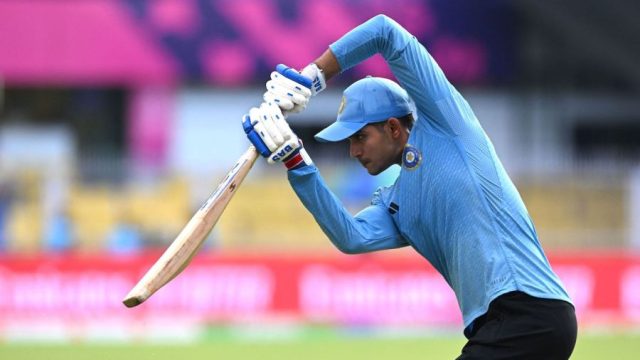Why Is It Called A Googly In Cricket?

In cricket, a ‘googly’ refers to a deceptive delivery that surprises the batsman. Unlike the standard leg-spinner’s delivery, which typically turns from leg to off, a googly turns in the opposite direction—from off to leg against a right-handed batsman. This unexpected turn is the essence of the googly’s deception, confusing batsmen and often leading to their dismissal. The term itself is steeped in the sport’s rich lexicon, and understanding why it’s called a googly adds a layer of appreciation for the nuance and history of cricket.
The mechanics of bowling a googly are complex, involving a precise grip and wrist action to achieve the reverse spin. Mastering this technique takes considerable skill and practice. Due to its tactical utility in deceiving batsmen, the googly is a prized weapon in a leg spinner’s arsenal. Over the years, prominent bowlers have crafted and refined their variation of the googly, contributing to its legendary status in cricket’s tactical playbook.
Key Takeaways
- A googly is a cricket delivery that unexpectedly turns from off to leg for a right-handed batsman.
- The deceptive nature of a googly can lead to batsman dismissals, making it a valuable tactical element in cricket.
- Skilled bowlers have honed the complexities of the googly, adding to its storied place in cricket history.
Googly Origins and Etymology
The googly’s origin in cricket is as fascinating as its deceptive nature on the field. This section will explore the inception of this unique delivery and the evolution of its name.
Invention of the Googly
The googly was conceived by English cricketer Bernard Bosanquet around the turn of the 20th century. It is a type of delivery bowled by a right-arm leg spin bowler, which, rather than turning from the leg to the off side, as expected, unexpectedly turns in the opposite direction—from the off to the leg side after pitching. Bosanquet developed this delivery initially whilst experimenting with a tennis ball during a game called ‘Twisti-Twosti. The effectiveness of the googly in cricket games, where it could bamboozle batsmen not anticipating the spin reversal, was quickly recognised and integrated into the sport.
Terminology
The term ‘googly’ itself has an uncertain etymology. One account suggests that it may derive from a Maori word, hinting at a linkage with early 20th-century cricket tours in New Zealand. However, it has also been referred to as a ‘Bosie’ after its inventor Bosanquet. The Australian cricketer Tom Horan is sometimes credited with first using the term ‘googly’ to describe this delivery during an Australian tour, although definitive evidence of this is scant. As a derivative of cricket terminology often steeped in colloquial language, the word ‘googly’ encapsulates the delivery’s whimsical and unforeseen nature, leading to its widespread and enduring use.
Mechanics of Bowling a Googly
The act of delivering a googly involves a specialised grip and wrist action that creates a spin opposite to a typical leg break. While the appearance of the ball’s trajectory suggests a leg break, the spin direction surprises the batsman by turning in the opposite direction.
Grip and Wrist Movement
The bowler grips the ball with the seam running horizontally across the palm. The middle finger and the third finger rest on either side of the seam while the thumb’s presence is minimal or nonexistent. The grip is firm yet finessed, allowing for subtle manipulations during release. The wrist plays a crucial role in the mechanics; it is cocked in a leg break position but rotates towards the back of the hand upon delivery, concealing the twist from the batsman.
Release and Spin Direction
As the bowler releases the ball, the action of the wrist and fingers imparts spin. It is critical that the ball rolls off the front of the fingers, particularly the third finger, to achieve the desired spin direction. A successful googly will turn towards the batsman if they are right-handed, akin to a wrong’un or twisti-twosti, rather than away as in a leg break. This deceptive spin is the hallmark of a well-executed googly, aimed to outfox the batsman expecting a typical leg break.
Tactical Use in Cricket Matches
The googly serves as a strategic weapon in a bowler’s arsenal, often deployed to outwit the batsman and prompt a wicket-taking opportunity. Its effective use involves a fusion of disguise and precise delivery that challenges batsmen across formats.
Strategies for Bowlers
A bowler integrates the googly into their repertoire to diversify their attack and introduce a level of unpredictability. They will typically utilise this delivery sparingly to ensure it retains its element of surprise. The key is in the disguise; the ball should ostensibly appear as a regular leg-spin delivery until it pitches and moves in the opposite direction.
- Bowlers must master varying the:
- Length to draw the batsman forward, making it harder to discern the spin.
- Pace, using a quicker delivery to rush the batsman or a slower one to induce error.
Bowlers may target the wicket directly, aiming to hit the batsman’s pads in hope of an lbw decision, or they might pitch the ball to induce a catch or have the batsman stumped if they venture out of their crease.
Challenges for Batsmen
Batsmen facing a googly must possess astute concentration and technical prowess to counteract its deceptive nature. As such, a batsman must refine their technique to address these unexpected deliveries effectively.
- Batsmen should:
- Watch the bowler’s hand closely to detect any subtle changes in grip or wrist action.
- Anticipate the ball’s behavior after pitching, which can involve either staying back in the crease or coming out to the pitch of the delivery to mitigate the spin.
The yorker-length googly can be particularly devastating, as responding to its low trajectory under the guise of a leg spin can catch batsmen off guard, leading to a bowled dismissal or leg before wicket. Hence, being able to judge the length quickly is crucial for batsmen to defend successfully or utilise attacking shots.
Training and Development
Developing the skill to deliver a googly requires a cricketer to balance technical proficiency with strategic acumen. Mastery is shaped by consistent practice and the ability to adjust to various playing surfaces.
Practice Techniques
Cricketers employ various practice techniques to hone the delivery of a googly. It begins in the nets, where bowlers can repetitively work on their form and wrist position without the pressure of a game situation. Utilising a tennis ball can help in developing the necessary flexibility in the wrist and fingers, allowing bowlers to impart the right spin on the ball. Sequenced drill exercises, alternating between leg-spin and googly deliveries, assist bowlers in achieving a seamless transition that can deceive batsmen during an international cricket match.
Adapting to Different Pitches
A key component of delivering an effective googly is understanding and adapting to different pitches. Pitches vary widely from region to region, and what works on a bouncy Perth surface may not hold up on a turning subcontinental pitch. Bowlers must practise on a variety of surfaces, adjusting their grip, spin, and seam position to maintain effectiveness. This adaptability is crucial when transitioning to international cricket, where playing conditions can change drastically from one venue to another.
Prominent Googly Bowlers
Cricket has seen many skilled practitioners of the googly, a deceptive delivery designed to bamboozle batsmen. The best googly bowler often combines elements of surprise with a mastery of spin.
- Abdul Qadir: The Pakistani leg-spinner rejuvenated the art of googly during the 1970s and 1980s. His name is synonymous with the delivery, and Qadir’s contributions have inspired subsequent generations.
- Shane Warne: This Australian legend was not just a magnificent leg spin bowler; his googlies were part of an extensive arsenal that made him one of the most feared bowlers in cricket history.
- Anil Kumble: Known for his accuracy and subtle variations, the Indian leg-spinner was more than adept at delivering a stumping-worthy googly. Kumble’s skill lay in his ability to bowl with a flatter trajectory, making his variations harder to read.
- Mushtaq Ahmed: A disciple of Abdul Qadir, Mushtaq carried forward the legacy of Pakistani leg spinners with his own brand of googlies, which were both effective and difficult to pick.
Here is a quick snapshot of these bowlers:
| Bowler name | Style of Play | Notable Feature of Googly |
|---|---|---|
| Abdul Qadir | Leg spin | Revival of the delivery |
| Shane Warne | Leg spin | Exceptional leg spin |
| Anil Kumble | Leg spin with flatter trajectory | Disguise and control |
| Mushtaq Ahmed | Leg spin | Pupil of Qadir’s technique |
Whilst the term ‘bosie’ is less commonly used, it is sometimes interchanged with “googly” and denotes the same type of delivery. Leg spinners predominantly execute the googly, though rare versions exist among off-spinners. Each of these bowlers has showcased the prowess of delivering a googly with their distinct approach, outfoxing batsmen across decades of international cricket.
Why Is It Called A Googly In Cricket? – Frequently Asked Questions
The term ‘googly’ sparks curiosity and evokes a rich history within the sport of cricket. This section addresses some of the most common queries regarding this distinctive bowling technique.
Where does the term ‘googly’ originate in cricket?
The name ‘googly’ is shrouded in etymological mystery with several theories about its origin, but one prevalent story links it to Bernard Bosanquet, the bowler credited with its invention. Some anecdotes connect ‘googly’ to a Maori word encountered during early cricket tours in New Zealand.
What is the distinction between a googly and a leg spin?
While a leg spin is a standard delivery turning from the leg to the off side for a right-handed batsman, a googly turns in the opposite direction. This inversion of spin is crafted to deceive the batsman, appearing as a leg spin but behaving contrary to expectations.
How is a googly delivered by a bowler?
To deliver a googly, the bowler uses a technique involving a unique grip and wrist movement that distinguishes the delivery from a conventional leg spin. The motion is designed to impart a spin that causes the ball to turn unexpectedly after pitching.
What role does the googly play in a bowler’s arsenal?
The googly serves as a surprise element within a leg-spin bowler’s repertoire, often used to disrupt a batsman’s rhythm and concentration. Its deceptive nature makes it a prized weapon, especially effective in tempting batsmen into making mistakes.
Can you explain the history behind the development of the googly in cricket?
The development of the googly is credited to Bernard Bosanquet around the turn of the 20th century. Over the years, iconic bowlers have refined the skill, encapsulating a legacy of complexity and artistry in the sport.
How does a batsman typically handle a bowler’s googly?
Experienced batsmen handle a googly by carefully watching the bowler’s hand at the point of release and playing the ball late. They often rely on subtle cues and practice to pick the variation from a bowler’s standard leg spin delivery.





